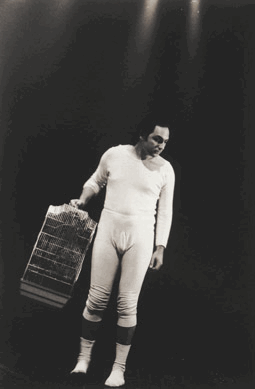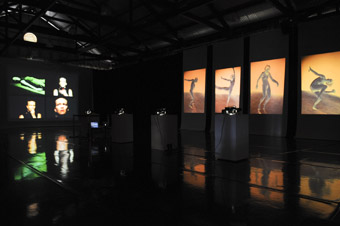calling the shots
virginia baxter: heidrun löhr, archive project

Jeff Stein, Cross Cuts, Performance Space, 2002
photos Heidrun Löhr
Jeff Stein, Cross Cuts, Performance Space, 2002
THE ATMOSPHERE AT HEIDRUN LÖHR’S SHOW AT CRITICAL PATH IS REVERENT, “ALMOST SPIRITUAL” SOMEONE SAYS. IT’S BEEN A WHILE SINCE I’VE ATTENDED AN EXHIBITION WHERE THE OPENING NIGHT AUDIENCE HAS TO BE PRISED AWAY FROM THE WORKS TO HELP THEMSELVES TO DRINKS.
Heidrun Löhr is acknowledged as the pre-eminent photographer to Sydney’s performance scene and tonight she invites us to see our shared history through her eyes. The vast expanses of the Drill Hall are moodily lit by projections. On hanging scrolls, 20 years of dance/performance history slips by in some 700 slides shown singly and in digital sequences. Her selection begins with Leisa Shelton’s The Girl Who Could See Air at the Toy Factory in Leichhardt (1989) and concludes with Running Behind Times (2009), a work she’s creating in collaboration with performer Rosie Dennis in the St James Railway tunnel. Four gently humming slide projectors are formally positioned on a line of plinths down the centre of the room. Composer Gail Priest’s delicate “Memory Machines” enhances the collective reverie.
In 2007 Heidrun Löhr received a two-year Australia Council for the Arts fellowship to catalogue and digitally transfer her photographic archive. Earlier this year, as the inaugural Artist in Residence at Critical Path she and director Margie Medlin hatched the idea of exhibiting an instalment from the archive representing an important part of the contemporary history of dance/performance in Sydney.
Equally surprised at the response to the installation Löhr modestly suggests, “A lot of the audience was also in the images so there were lots of personal memories and more collectively of the performance community…and the sound held it all together.” I ask how she decided on the installation format. “My archive is based on slides and negatives and film—analogue technology. Of course, I switched to digital some years ago, but it occurred to me it would be interesting to have both technologies together because the archive has changed enormously over the last few years as well. Also at that time Russell Emerson at the Department for Performance Studies told me he’d just got hold of 13 slide projectors that some other university department had thrown out. I thought, great, I’ll use those!”

Fiona Malone, Ros Crisp in Projections, Heidrun Löhr
photo Heidrun Löhr
Fiona Malone, Ros Crisp in Projections, Heidrun Löhr
“I wanted to have the images not on the usual projection screens. The Drill Hall is so high and I thought it would be beautiful to have a scroll hanging down. Always the idea was to work with sequences and with single images. Gail came in and taped the sound of the projectors and we talked about nostalgia. The rhythm was important to me—the rhythm of the slide show and the rhythm of the sequences.”
Asked how she selected from so many possible images, Löhr replies, “I had a look at the Drill Hall and I thought I could do something incredibly small or very big. I decided on big. Big prints are expensive so I thought about projections, also because performance is a very ephemeral art. With projections you turn off the electricity and it’s all gone. So it somehow seemed appropriate. My choice was always based on movement. That was the focus that eventually held it together.
“For me it also has to do with performance photography. I don’t (simply) document so much as interpret a work. I decided to include a number of blurry images, the ones that aren’t usually printed or published, so a broader audience is not seeing them. As a photographer I’m working with light and the performers leave traces of light and the more they move the more traces there are. And, of course, I work with the lighting designer because I work with his or her light. Also I wanted to show more than one image of the work of one dancer or performer. For instance, you see Jeff Stein at Performance Space in Cleveland Street in 2002 and then again at Night Time in 2008 at CarriageWorks. In some of the sequences there’s just a small time lapse in between the development of a movement or gesture and sometimes the movement is quite ferocious.
“There’s a sequence of photographs from Force Majeure’s Already Elsewhere (2005) with the dancers on a roof. While I was photographing the dress run, I had the shutter open for quite a while. So you see the bodies travelling through space and time. They become quite abstract. There’s a certain beauty in it. Perhaps it’s also a desire on the part of the photographer to move away from reality. We always somehow need reality, not like a painter who can just make something up.”
Another spin-off from the Archive Project for Löhr is a developing interest in animation. “I’m working with Rosie Dennis and also with Nikki Heywood. Within 5 days, I took about 3000 images in the apartment where Nikki’s mother used to live until she had a number of falls and had to move into a nursing home” (see page 55).
We talk about the future of the Archive. “It was fantastic to have the fellowship. When I wrote the proposal, I was not aware how time consuming it would be. I’m working in collaboration with the Fisher Library and the Department for Performance Studies. Over those two years I have continuously gone through the proof sheets. I started with 2000 but then I went to 1990. Each year has five or six folders. In each folder there are approximately 100 films, 100 proof sheets, 35 images each. Between 1 and 6 will be good ones. I choose the images I think are interesting, ‘representing’ the work and then I write all the information. The problem has been finding someone to scan these images in because the archive will be digital. We’ve found someone in Adelaide who can do it but it’s quite expensive so the Fisher Library will need more funding. So I created this brochure on The Archive Project to go out to potential sponsors like Nikon—I’ve used a Nikon camera all my photographic life. I have about 500 images we will send to Adelaide and these 500 slides or digitalised negatives plus digital material will act as a trailer on the library’s website. All this will hopefully happen by the end of the year or early next year.” For the time being the archive is held at the Department for Performance Studies.
Heidrun Löhr’s archive is of great historical and educational importance, her striking images evidence of Löhr’s deep connection with the work she has lovingly photographed over the decades. Of course, she continues to do so as the pages of RealTime regularly attest. Its documentary function aside, the collection also represents a powerful body of work from a significant Australian artist.
Projections, The Archive Project Heidrun Löhr, Critical Path, The Drill Hall, Sydney, May 13-17
RealTime issue #92 Aug-Sept 2009 pg. 20






